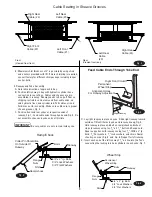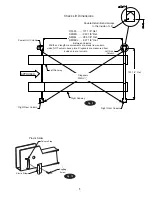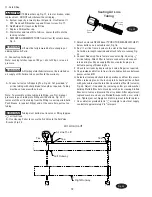
2
Required Clearances
Read and understand Installation Instructions completely
before starting with lift installation.
1. Lift Location: Use architects plan when available to locate lift.
Fig. 1 shows dimensions of a typical bay layout. For power
unit at right front, rotate lift 180°, leaving ramp/chocks and
wheel stops in original position. Lift floor area should be
level.
WARNING
DO NOT install on asphalt or other similar
unstable surfaces. Columns are supported only by anchors in
floor.
Note: If runway extensions are used, an additional 3’–0” of
clearance must be added to end with extensions.
2. Ceiling or overhead clearance must be 80” plus height
of tallest vehicle.
3. Estimating Column Shim requirements:
In the following section, the terms “highest” and
“lowest” refer to elevation of floor.
A. Mark locations where lift columns will be
positioned in bay.
B. Place target at column positions and record
readings, Fig. 2.
C. Find the highest of the four (4) locations. Find the
difference between the reading at each of the
remaining three (3) columns and the highest
reading.
D. The difference is the estimated amount of shim
thickness needed at each column.
Fig. 2
Fig. 1
APPROACH
C
L
Left
Runway
Right
Runway
Rear Clearance
Rear Clearance (Min. 5'-6" for SM30's, 8'-6" for
RFL25's) = rear overhang of longest v required
work space
Front Clearance
8'–0" Min. To
Nearest
Obstruction
8'–0" Min. To
Nearest
Obstruction
FRONT
REAR
Front Clearance = front overhang of
longest v required work space
Transit
Estimation Shim Requirements
Target
Dimension at highest position minus other
position = shim thickness required
Summary of Contents for RFL25
Page 14: ...NOTES ...
Page 15: ...NOTES ...


































